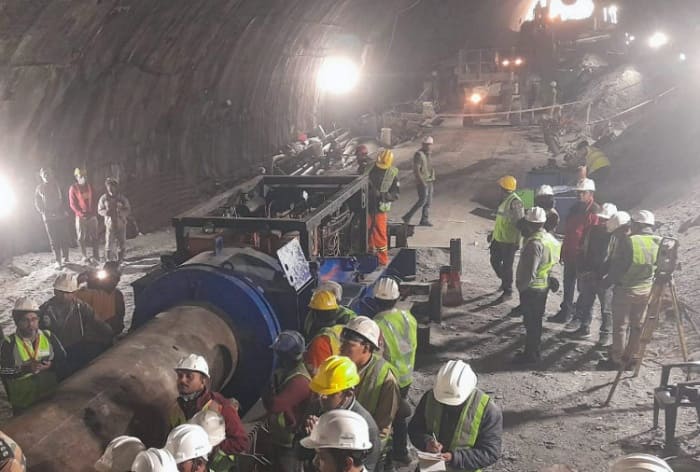Uttarakhand tunnel collapse: Rescue operations continue on day 6 as giant drill drills into rubble; Backup equipment on the go
The rescue operation at the under-construction Silkyara Tunnel on Char Dham route in Uttarakhand continued for the sixth day in a row on Friday.
Uttarakhand Tunnel Collapse: Rescue workers had drilled through 80 feet of rubble into a collapsed tunnel here until Friday evening, with less than half of the rubble blocking the way to the 40 workers trapped for more than five days.
Equipment similar to the 25-ton US-made machine now in use was also flown in from Indore as a “back-up” for the rescue operation at the under-construction Silkyara Tunnel on the Char Dham route in Uttarakhand.
An official from the National Highways & Infrastructure Development Corporation, the company charged with building the tunnel, dismissed reports that rescue efforts were hampered by technical problems with the American drill.
The rescue operation continues at #Uttarkashi tunnel accident. The lives of 40 workers are at risk due to the breaking of part of the tunnel pic.twitter.com/D9rH7UgPXd
— Upendrra Rai (@UpendrraRai) November 17, 2023
The machine from Indore was only as a backup so that rescue work could continue uninterrupted, he told reporters.
It was previously said that the ‘state-of-the-art’ machine would have a drilling capacity of up to four to five meters per hour. But the operation has so far progressed at a rate of less than one meter per hour since it was deployed on Thursday morning.
The workers are trapped behind a 200-foot stretch of rubble and are piped to food, water and medicine. They are in constant contact, officials said.
The plan is to insert six meters of steel pipes one after the other as the machine drills through the rubble. Each tube has a diameter of 800 or 900 mm.
The fifth pipe was inserted on Friday afternoon.
Asked why the machine had not reached the “expected” speed, NHIDCL Managing Director Anshu Manish Khalkho told reporters that aligning the pipes and welding them before pushing them through the rubble takes time.
The operation must be interrupted every now and then, Khalkho said, referring to the fumes created by the diesel-powered machine in a nearby area and the vibrations created in the tunnel due to the drilling.
He said the machine has been working satisfactorily and its speed will increase as rescuers become accustomed to the process.
Asked whether vertical drilling to save the workers was also being considered, Khalko said a study for the same was being conducted.
However, he said the horizontal drilling now being carried out was the best option as a previous study had shown the other method could lead to more debris.
Relatives of the trapped workers and officials from their home countries came to the rescue site and were able to talk to them through a pipe running through the rubble.
‘My cousin is one of the prisoners. I spoke to him. He said he was fine,” said Shatrughan Lal, a resident of Uttar Pradesh.
A man from UP’s Lakhimpur Kheri also spoke to his son. “He asked me not to get tense because he is fine. The authorities have asked us to wait patiently. All I wish is that he comes out safely.”
A spokesperson of Navayuga Engineering Company told PTI: “The trapped workers have been given food. They’re fine. The auger machine also works well. We pray to God that they are evacuated as soon as possible.”
The American jacking machine was flown from Delhi in separate parts on the IAF’s Super Hercules aircraft on Wednesday and later assembled on site. It replaced previous drilling equipment as it could only penetrate debris up to 45 meters deep, said Adesh Jain, an expert involved in the operation.
That in turn had to be replaced with the heavier and more efficient machine as the debris later spread over a stretch of about 70 metres, Jain said.
The ‘spare’ machine was flown to Dehradun’s Jolly Grant airport by the IAF’s C-17 Globemaster aircraft, much larger than the Super Hercules aircraft now fielding the equipment.
The rescue work is being carried out round the clock by 165 personnel from multiple agencies, including the National Disaster Response Force, State Disaster Response Force, Border Roads Organization and the Indo-Tibetan Border Police, the State Emergency Operation Center said.
The area where the fallen debris section begins is 270 meters from the mouth of the tunnel on the Silkyara side.
(Only the headline has been reworked by India.com staff. Copy is from an Agency feed)


